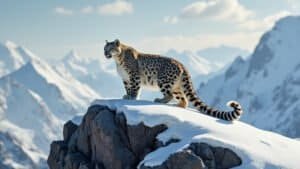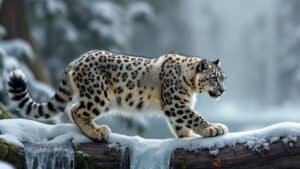Introduction
Snow leopards are remarkable predators, perfectly adapted to the rugged, mountainous terrains of Central Asia. A key factor in their survival is their unique skeletal structure, which enables them to perform high-impact movements with agility and precision
This article explores the specialized features of snow leopard bones, focusing on their structural adaptations, bone composition, and evolutionary significance. From the powerful leg bones that allow them to leap great distances to the flexible spine that supports their acrobatic movements, each aspect of their skeletal system plays a crucial role in their ability to hunt and thrive in harsh environments
Skeletal Adaptations for High-Impact Movements
Snow leopards, renowned for their ability to navigate the steep, rocky terrains of the Himalayas and other mountainous regions, rely heavily on their uniquely adapted skeletal structure. These adaptations not only allow them to leap great distances but also enable them to absorb the shock of landing on uneven surfaces, making them one of the most agile and resilient big cats
The skeletal system of a snow leopard is a marvel of evolutionary engineering, designed to support high-impact movements essential for their survival in harsh, high-altitude environments
The Unique Structure of Snow Leopard Leg Bones
The leg bones of snow leopards are particularly robust and dense, designed to withstand the immense forces generated during leaps and landings. The femur, tibia, and fibula are thicker compared to other big cats, providing the necessary strength to support their powerful hindquarters
This increased bone density is crucial for absorbing the impact when landing from heights of up to 50 feet, a common feat for these agile predators. The joints, especially the knee and ankle joints, are reinforced with strong ligaments and tendons that provide both stability and flexibility, enabling snow leopards to maneuver quickly and efficiently across rocky and uneven terrains
The paws of snow leopards also play a significant role in their high-impact movements. The metatarsal bones are elongated, which increases the surface area of the paws, acting like natural shock absorbers
This adaptation not only helps in cushioning the impact during landings but also provides additional grip on snow and ice, preventing slips and falls. The combination of strong leg bones and specialized paw structure allows snow leopards to execute powerful jumps and landings without sustaining injuries, a critical ability for hunting prey in their challenging habitat
How Snow Leopard Spine Supports Flexibility and Agility
The spine of the snow leopard is another key feature that contributes to its remarkable agility. Composed of highly flexible vertebrae, the spine allows for an extensive range of motion, which is essential for the acrobatic maneuvers these cats are known for
The lumbar vertebrae, in particular, are highly flexible, enabling the snow leopard to twist and turn its body mid-air during leaps or while chasing prey. This flexibility is further enhanced by the elongated and muscular nature of the spine, which provides both strength and suppleness
In addition to flexibility, the snow leopard’s spine is designed to absorb the impact of landing from great heights. The intervertebral discs, which are composed of cartilage and act as cushions between the vertebrae, are thicker and more resilient in snow leopards compared to other felines
This ensures that the force of impact is evenly distributed along the spine, minimizing the risk of injury. The overall structure of the spine, with its combination of strength and flexibility, plays a crucial role in the snow leopard’s ability to navigate its mountainous environment with ease
Bone Density and Strength in Snow Leopards
Bone density is a critical factor in the snow leopard’s ability to withstand the physical demands of its environment. Studies have shown that snow leopards possess a higher bone mineral density (BMD) compared to other big cats
This increased density provides additional strength and durability, which is necessary for the high-impact activities that are a regular part of their lives. The dense bones are less prone to fractures and other injuries, which is vital for an animal that frequently jumps from significant heights and lands on hard, uneven surfaces
Moreover, the bone structure of snow leopards includes a high concentration of cortical bone, the dense outer surface of bone that provides most of its strength
This is particularly evident in the long bones of the legs and the vertebral column, where additional strength is required to support the animal’s weight during movement and to absorb the forces generated during high-impact activities. The combination of high bone density and a robust skeletal structure allows snow leopards to perform the extraordinary physical feats that are essential for their survival
Bone Composition and Durability
The exceptional durability of snow leopard bones is a product of their unique composition. These bones are not just strong but are also optimized to withstand the stresses and strains of a high-altitude, rugged environment
The composition of snow leopard bones plays a crucial role in ensuring they remain resilient and functional, even under extreme physical demands
This section explores the specific elements that contribute to the strength and durability of snow leopard bones, including the critical roles of collagen, calcium, and the comparison of their bones to those of other big cats
The Role of Collagen and Calcium in Snow Leopard Bones
Collagen and calcium are fundamental components of snow leopard bones, each contributing to different aspects of bone strength and flexibility. Collagen, a fibrous protein, provides the necessary framework for bone structure, giving it flexibility and the ability to absorb shock
In snow leopards, the collagen fibers are densely packed and organized in a way that maximizes the bone’s ability to bend slightly without breaking, a vital feature when landing from great heights or making sharp turns during a chase
Calcium, on the other hand, is responsible for the hardness and strength of the bones. Snow leopard bones have a high concentration of calcium phosphate, which forms a crystalline structure within the collagen matrix
This mineralization process is what gives the bones their rigidity and ability to bear significant loads without deforming. The high levels of calcium in snow leopard bones ensure that they remain strong and resistant to fractures, even under the intense physical pressures associated with their active lifestyle
The interplay between collagen and calcium in snow leopard bones creates a unique balance of strength and flexibility, allowing these animals to engage in high-impact movements without sustaining serious injuries. This combination is critical for their survival, enabling them to hunt, leap, and navigate their challenging environments effectively
Comparative Analysis of Snow Leopard Bones with Other Big Cats
When comparing the bones of snow leopards to those of other big cats, several key differences emerge, particularly in terms of density and structural adaptations. For instance, snow leopard bones are generally denser and thicker than those of other felids, such as lions or tigers
This increased density is a direct adaptation to the high-altitude environments in which snow leopards live, where the terrain is often rocky, and the need for strong, impact-resistant bones is paramount
One of the most significant differences is found in the long bones of the limbs. Snow leopard femurs and tibias are not only thicker but also have a higher cortical bone thickness, which provides additional strength and resistance to bending forces
This adaptation is less pronounced in big cats that live in more temperate environments, where the need for such robust bone structure is reduced due to less extreme terrain
Additionally, the vertebrae of snow leopards are more flexible compared to those of other big cats. This flexibility is an adaptation to their need for agility and balance while navigating steep and uneven terrain
The increased flexibility in the spinal column of snow leopards is achieved through a combination of highly elastic intervertebral discs and a greater range of motion in the joints between vertebrae, allowing for more pronounced twisting and bending motions
How Bone Composition Affects Snow Leopard Mobility
The specific composition of snow leopard bones has a direct impact on their mobility, particularly in the challenging environments they inhabit
The combination of dense, mineralized bones with flexible collagen-rich structures allows snow leopards to perform a range of high-impact movements without compromising their skeletal integrity. This adaptability is crucial for their ability to leap between cliffs, chase prey across rocky landscapes, and survive in areas where falls or slips could be fatal
Moreover, the enhanced durability of their bones allows snow leopards to maintain high levels of physical activity throughout their lives, a necessity for hunting in their sparse, mountainous habitats. Unlike some other big cats, snow leopards do not rely on sheer speed to catch their prey; instead, they depend on their ability to move stealthily, jump great distances, and make quick, agile movements to capture their food
The bone composition of snow leopards, therefore, not only supports their physical demands but also underpins their entire hunting strategy, allowing them to thrive in environments that would be inhospitable to less adapted species
The integration of strength, flexibility, and density in snow leopard bones is a remarkable example of evolutionary adaptation, providing these animals with the necessary tools to survive and succeed in one of the most challenging habitats on Earth
Evolutionary Significance of Snow Leopard Skeletal Features
The skeletal features of snow leopards are not just adaptations to their current environment but also a product of millions of years of evolution. These features have developed to meet the specific demands of their high-altitude habitats, where survival depends on agility, strength, and the ability to endure extreme conditions
This section explores the evolutionary significance of these skeletal adaptations, how they contribute to the snow leopard’s hunting techniques, and how these features compare to those of related species
Adaptations for Survival in High-Altitude Environments
Snow leopards inhabit some of the highest and most rugged terrains in the world, including the Himalayas, the Tibetan Plateau, and the mountains of Central Asia. These environments pose unique challenges that have driven the evolution of their skeletal structure
One of the most critical adaptations is the increased bone density found in snow leopards, which is essential for withstanding the impact of jumping across rocky outcrops and landing on uneven surfaces
The skeletal structure of snow leopards also includes specialized adaptations in the limbs and spine that allow for greater flexibility and balance. For instance, their hind limbs are longer than their front limbs, providing the leverage needed to leap across large gaps between rocks
This limb structure is complemented by a highly flexible spine that enables snow leopards to twist and turn their bodies mid-air, ensuring they land safely even on precarious surfaces
These adaptations are particularly important in high-altitude environments where oxygen levels are low, and the terrain is both steep and treacherous. The ability to move quickly and efficiently across such landscapes is a key survival trait, enabling snow leopards to hunt effectively and evade potential threats
Impact of Skeletal Features on Snow Leopard Hunting Techniques
The unique skeletal features of snow leopards have a direct impact on their hunting strategies. Unlike big cats that rely on speed and endurance to chase down prey, snow leopards use stealth, strength, and agility to catch their food
Their powerful hind limbs and flexible spine allow them to ambush prey from a distance, often leaping several times their body length to surprise their target
Once in pursuit, the dense and robust bones of the snow leopard’s limbs allow them to make quick, agile movements even on the most challenging terrain. Their ability to absorb the shock of landing from significant heights without injury gives them a distinct advantage in mountainous environments where their prey may seek refuge on steep cliffs or rocky ledges
Additionally, the snow leopard’s large paws, supported by a strong skeletal framework, provide excellent traction on snow and ice, further enhancing their ability to pursue prey across slippery surfaces. This combination of skeletal strength and agility enables snow leopards to hunt effectively in environments where other predators might struggle
Evolutionary Comparisons with Related Species
When comparing snow leopards to their closest relatives, such as tigers and leopards, several evolutionary differences in skeletal structure become apparent. While all these big cats share a common ancestor, snow leopards have evolved distinct skeletal features that reflect the demands of their high-altitude environments
For example, the limb bones of snow leopards are shorter and more robust compared to those of leopards, reflecting their need for power rather than speed. The vertebral column of snow leopards is also more flexible than that of tigers, an adaptation that enhances their ability to navigate the steep and rocky terrain of their habitat
Moreover, the skull of the snow leopard is relatively smaller and lighter compared to other big cats, reducing the overall weight they must carry when leaping between rocks or climbing steep inclines
This reduction in skull size is offset by a powerful jaw structure, which enables snow leopards to deliver a strong, precise bite to subdue prey quickly
These evolutionary differences highlight the ways in which snow leopards have adapted to their specific environment, developing a skeletal structure that supports their unique lifestyle and hunting strategies. The evolution of these features has allowed snow leopards to thrive in some of the most inhospitable regions of the world, where few other large predators can survive
Conclusion
The snow leopard’s skeletal structure is a remarkable example of evolutionary adaptation, perfectly tailored to meet the demands of its rugged, high-altitude environment. From the dense, robust bones that provide strength and shock absorption, to the flexible spine that supports agility and balance, every aspect of their skeletal system plays a crucial role in their survival
These adaptations not only enable snow leopards to execute high-impact movements essential for hunting and navigating their terrain, but also ensure they remain resilient in one of the most challenging habitats on Earth
Understanding these unique skeletal features highlights the extraordinary ways in which snow leopards have evolved to thrive where few others can, showcasing the incredible interplay between form, function, and environment in the natural world













